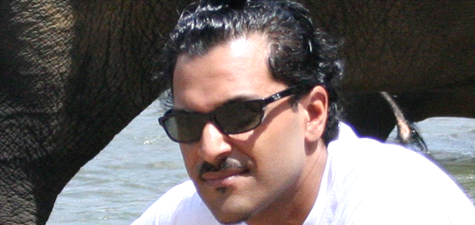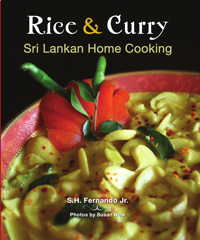
What is Sri Lankan food all about?
HOT!
We’re talking mouth-scorching, peppery hot.
It’s a hot country and they like to sweat when they eat.
S. H. Fernando’s Jr.‘s Rice and Curry: Sri Lankan Home Cooking (Hippocrene 2012) is a very good introduction to the island and its cuisine written by a Sri Lankan-American music journalist. There is a guidebook tacked onto this recipe book, since Sri Lanka is not well known in the West – and the author is a fine guide to the culture and people.
Rice and curry is folk cooking, prepared and eaten every day at home. The complexity of flavors masks the ease of preparation. While you may be intimidated at first by the strange ingredient and the complete novelty of it all, the best way of learning is by doing. (p. x)
You may be familiar with the Tamil Sinhalese war of the last 30-years that is now largely over. Time to visit Sri Lanka!
Sri Lankan is an island dominated by the spices and tea it grows that have lured European and Asian invasions. The cuisine makes good use of the native spices, often in similar ways as in Indian cuisine. Some of the more unusual ingredients Fernando describes are: Camboge, a sour fruit; Pandanus (Rampe), the leaf of the umbrella tree used to flavor rice; and fresh mace and nutmeg.
 Jump to the chapter on rice, since it is the staple of Sri Lankan. Even Basic Rice (p. 66) is flavored with curry leaves, cardamom, and pandanus – served with cashews and raisins as a garnish in an almost Middle Eastern turn. Yellow Rice (p. 67) includes turmeric for color and flavor, but also lemongrass, cinnamon, curry leaves, cardamom and chicken stock. Milk Rice (p. 69), a dish of long grain rice cooked with coconut milk, is reserved for important occasions. In the accompanying photograph by Susan Now, it is pink from added jaggery (palm sugar).
Jump to the chapter on rice, since it is the staple of Sri Lankan. Even Basic Rice (p. 66) is flavored with curry leaves, cardamom, and pandanus – served with cashews and raisins as a garnish in an almost Middle Eastern turn. Yellow Rice (p. 67) includes turmeric for color and flavor, but also lemongrass, cinnamon, curry leaves, cardamom and chicken stock. Milk Rice (p. 69), a dish of long grain rice cooked with coconut milk, is reserved for important occasions. In the accompanying photograph by Susan Now, it is pink from added jaggery (palm sugar).
There are plenty of curry recipes to go with the spicy rice. Chicken Curry (p. 87) has a long list of spices in addition to the roasted curry powder (p. 41) for which you will need a coffee grinder. There are some very unusual recipes like Duck Curry with Arrack (p. 99) that dates back to the British colonial era. It includes the palm flower liquor. Perhaps the most prized recipe in the book is Leela’s Chilaw Crab Curry (p. 111). It follows a long essay about a Leela, an elderly servant of his aunt’s, who is the family’s cook and general maid. Her curry is famous in the family – usually made from the large lagoon crabs of her area. He carefully notes down how she makes the dish and then describes the trip back to her home village where she will retire with her sister’s family. The women in the village house cook on an open-hearth chicken curry, coconut sambol (p. 163), cashew curry (p. 139), jackfruit, rice, paripoo (lentils), and crisp papadum (p. 109). At the end of the book is Leela’s Legendary Milk Toffee (p. 188) made of sweetened condensed milk, sugar, and butter – that would cool anyone’s mouth.
There are other good essays in the book – on visiting a Sri Lankan market (p. 126-9) with vibrant photographs of fruit and vegetables – some of which are not in Western markets. S. H. Fernando Jr.’s recipes are from his extended family – really a chronicle of year spent immersed in Sri Lanka. It is a good introduction with warm stories and easy to follow recipes – get it before going and you’ll have a richer trip.

1 comments on “S. H. Fernando: Rice and Curry”